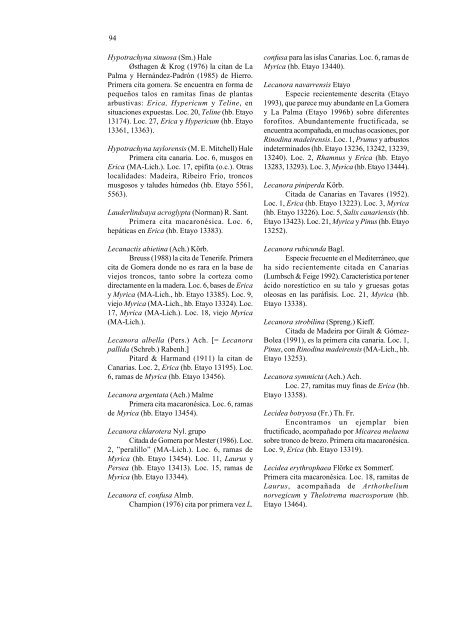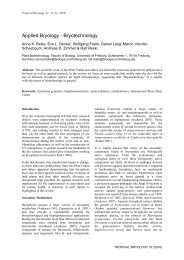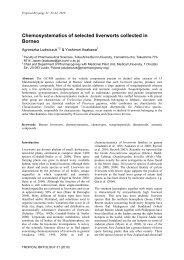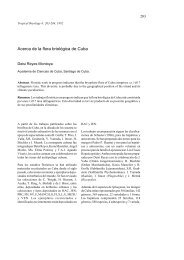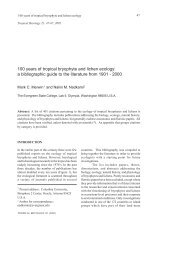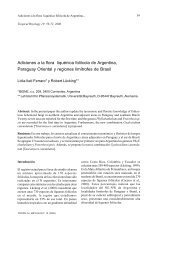Aportación a la flora liquénica de las Islas ... - Tropical Bryology
Aportación a la flora liquénica de las Islas ... - Tropical Bryology
Aportación a la flora liquénica de las Islas ... - Tropical Bryology
You also want an ePaper? Increase the reach of your titles
YUMPU automatically turns print PDFs into web optimized ePapers that Google loves.
94<br />
Hypotrachyna sinuosa (Sm.) Hale<br />
Østhagen & Krog (1976) <strong>la</strong> citan <strong>de</strong> La<br />
Palma y Hernán<strong>de</strong>z-Padrón (1985) <strong>de</strong> Hierro.<br />
Primera cita gomera. Se encuentra en forma <strong>de</strong><br />
pequeños talos en ramitas finas <strong>de</strong> p<strong>la</strong>ntas<br />
arbustivas: Erica, Hypericum y Teline, en<br />
situaciones expuestas. Loc. 20, Teline (hb. Etayo<br />
13174). Loc. 27, Erica y Hypericum (hb. Etayo<br />
13361, 13363).<br />
Hypotrachyna taylorensis (M. E. Mitchell) Hale<br />
Primera cita canaria. Loc. 6, musgos en<br />
Erica (MA-Lich.). Loc. 17, epifita (o.c.). Otras<br />
localida<strong>de</strong>s: Ma<strong>de</strong>ira, Ribeiro Frío, troncos<br />
musgosos y talu<strong>de</strong>s húmedos (hb. Etayo 5561,<br />
5563).<br />
Lau<strong>de</strong>rlindsaya acroglypta (Norman) R. Sant.<br />
Primera cita macaronésica. Loc. 6,<br />
hepáticas en Erica (hb. Etayo 13383).<br />
Lecanactis abietina (Ach.) Körb.<br />
Breuss (1988) <strong>la</strong> cita <strong>de</strong> Tenerife. Primera<br />
cita <strong>de</strong> Gomera don<strong>de</strong> no es rara en <strong>la</strong> base <strong>de</strong><br />
viejos troncos, tanto sobre <strong>la</strong> corteza como<br />
directamente en <strong>la</strong> ma<strong>de</strong>ra. Loc. 6, bases <strong>de</strong> Erica<br />
y Myrica (MA-Lich., hb. Etayo 13385). Loc. 9,<br />
viejo Myrica (MA-Lich., hb. Etayo 13324). Loc.<br />
17, Myrica (MA-Lich.). Loc. 18, viejo Myrica<br />
(MA-Lich.).<br />
Lecanora albel<strong>la</strong> (Pers.) Ach. [= Lecanora<br />
pallida (Schreb.) Rabenh.]<br />
Pitard & Harmand (1911) <strong>la</strong> citan <strong>de</strong><br />
Canarias. Loc. 2, Erica (hb. Etayo 13195). Loc.<br />
6, ramas <strong>de</strong> Myrica (hb. Etayo 13456).<br />
Lecanora argentata (Ach.) Malme<br />
Primera cita macaronésica. Loc. 6, ramas<br />
<strong>de</strong> Myrica (hb. Etayo 13454).<br />
Lecanora ch<strong>la</strong>rotera Nyl. grupo<br />
Citada <strong>de</strong> Gomera por Mester (1986). Loc.<br />
2, ”peralillo” (MA-Lich.). Loc. 6, ramas <strong>de</strong><br />
Myrica (hb. Etayo 13454). Loc. 11, Laurus y<br />
Persea (hb. Etayo 13413). Loc. 15, ramas <strong>de</strong><br />
Myrica (hb. Etayo 13344).<br />
Lecanora cf. confusa Almb.<br />
Champion (1976) cita por primera vez L.<br />
confusa para <strong>la</strong>s is<strong>la</strong>s Canarias. Loc. 6, ramas <strong>de</strong><br />
Myrica (hb. Etayo 13440).<br />
Lecanora navarrensis Etayo<br />
Especie recientemente <strong>de</strong>scrita (Etayo<br />
1993), que parece muy abundante en La Gomera<br />
y La Palma (Etayo 1996b) sobre diferentes<br />
forofitos. Abundantemente fructificada, se<br />
encuentra acompañada, en muchas ocasiones, por<br />
Rinodina ma<strong>de</strong>irensis. Loc. 1, Prunus y arbustos<br />
in<strong>de</strong>terminados (hb. Etayo 13236, 13242, 13239,<br />
13240). Loc. 2, Rhamnus y Erica (hb. Etayo<br />
13283, 13293). Loc. 3, Myrica (hb. Etayo 13444).<br />
Lecanora piniperda Körb.<br />
Citada <strong>de</strong> Canarias en Tavares (1952).<br />
Loc. 1, Erica (hb. Etayo 13223). Loc. 3, Myrica<br />
(hb. Etayo 13226). Loc. 5, Salix canariensis (hb.<br />
Etayo 13423). Loc. 21, Myrica y Pinus (hb. Etayo<br />
13252).<br />
Lecanora rubicunda Bagl.<br />
Especie frecuente en el Mediterráneo, que<br />
ha sido recientemente citada en Canarias<br />
(Lumbsch & Feige 1992). Característica por tener<br />
ácido norestíctico en su talo y gruesas gotas<br />
oleosas en <strong>la</strong>s paráfisis. Loc. 21, Myrica (hb.<br />
Etayo 13338).<br />
Lecanora strobilina (Spreng.) Kieff.<br />
Citada <strong>de</strong> Ma<strong>de</strong>ira por Giralt & Gómez-<br />
Bolea (1991), es <strong>la</strong> primera cita canaria. Loc. 1,<br />
Pinus, con Rinodina ma<strong>de</strong>irensis (MA-Lich., hb.<br />
Etayo 13253).<br />
Lecanora symmicta (Ach.) Ach.<br />
Loc. 27, ramitas muy finas <strong>de</strong> Erica (hb.<br />
Etayo 13358).<br />
Leci<strong>de</strong>a botryosa (Fr.) Th. Fr.<br />
Encontramos un ejemp<strong>la</strong>r bien<br />
fructificado, acompañado por Micarea me<strong>la</strong>ena<br />
sobre tronco <strong>de</strong> brezo. Primera cita macaronésica.<br />
Loc. 9, Erica (hb. Etayo 13319).<br />
Leci<strong>de</strong>a erythrophaea Flörke ex Sommerf.<br />
Primera cita macaronésica. Loc. 18, ramitas <strong>de</strong><br />
Laurus, acompañada <strong>de</strong> Arthothelium<br />
norvegicum y Thelotrema macrosporum (hb.<br />
Etayo 13464).


